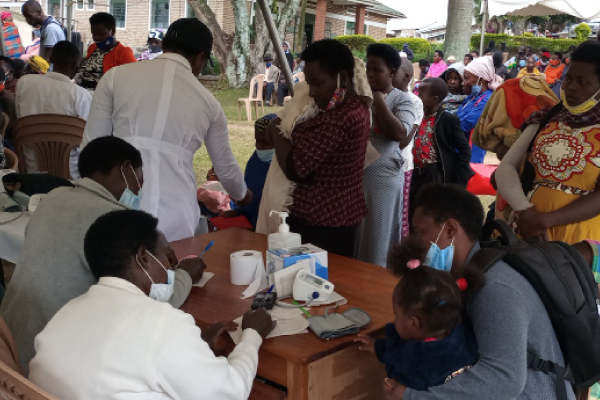Prime
The tests you need for proper diagnosis

Sometimes, the doctor needs to know at what speed the disease is growing in your body so that they can come up with the right medicines and treatment for you. PHOTO | COURTESY
What you need to know:
- A misdiagnosis can have serious consequences on a person’s health, delay recovery and sometimes calls for treatment that is harmful or even fatal. Beatrice Nakibuuka explores the right procedures for proper diagnosis.
According to 2019 reports by Docpanel, around 12 million adults receive a misdiagnosis every year. That is one out of every 20 adults seeking outpatient care. A misdiagnosis that is not corrected can lead to unnecessary and potentially harmful treatments, physical and emotional pain, increased costs and even loss of life.
According to Dr Vincent Karuhanga, a general practitioner, diagnosis is one of the most difficult things because it happens by elimination. Most diseases, he says, have similar signs and symptoms and, therefore, make relevant the specialty of lab scientists.
“Proper diagnosis depends on signs and symptoms, taking patient history and this constitutes about 65 per cent of the diagnosis. However, it cannot be conclusive until laboratory examinations are done on blood, stool, urine, semen or any other fluids and these will help give the right diagnosis,” he says.
May-Lyton Namata, a laboratory technologist at Sinux Laboratories in Kyanja, says there is a gap in diagnosis in Uganda and many people are treated clinically with mere physical examination and a little background study without doing a thorough diagnosis from the laboratory.
For this reason, many get false positives and are treated for wrong diseases. The treatment given may be able to manage the signs and symptoms and the parasites below a level when it cannot be detected but the person may develop another disease that may be harder to treat.
From her own research, Namata says out of the many treatment centres on Kisasi-Kyanja Road, only three have a CBC machine and two of these are three part machines that do not give full details of a full blood count results because it aggregates some of them. This, according to her, may not give the best results.
If someone has malaria for instance, there is usually a drop in the number of platelets, red blood cells and haemoglobin level. This can only be detected by a five part or more machine that is able to clearly show these numbers.
“When a person comes with symptoms of malaria, we usually use an RDT or blood slide but the results may not be as conclusive. It is, therefore, important that the lab technologist does a CBC. In the early stages of malaria, the drop in the components of blood may not be significant but it is there. We can also do a urinalysis to check for malaria. The urine of a person with malaria has some blood,” she says.
Complete blood count
A complete blood count also known as CBC is a baseline of what your blood looks like at the time. It is used to evaluate your overall health and detect a wide range of disorders, including anemia, infection, worms, allergies, viral or bacterial infection and leukemia.
This blood test measures the different components and features of your blood giving the quantities of each type and their distribution in a given amount of blood. The components include red blood cells, which carry oxygen, white blood cell count, platelet count and haemoglobin.
This system of diagnosis has more than 30 parameters and when a person presents with symptoms such as fever, joint pain, general body weakness, inflammation, bruising or bleeding, the doctor should recommend a CBC because they are symptoms of an infection.
Any abnormal increases or decreases in cell counts (judged against the standard normal) as revealed in a complete blood count may indicate that you have an underlying medical condition that calls for further evaluation.
Depending on the results, the doctor may recommend a complete blood count as part of a routine medical examination to monitor your general health and to screen for a variety of disorders.
A CBC may not be a definitive diagnostic test and depending on the reason why your doctor recommended this test, results outside the normal range may or may not require follow-up.
Urinalysis
This test is usually recommended for women who present with fever, joint, back and abdominal pain, general weakness because these are signs of a urinary tract infection (UTI). This is because a woman’s urethra is short, which makes them prone to UTIs.
A urinalysis test can also be used to reveal dehydration or starvation, the level of glucose in blood (diabetes) and liver or kidney damage.
Microscopy can further be used to detect any pus cells, yeast cells or any parasites that cause bilharzia. This helps to give the direction of diagnosis and from this, the lab technologist will do a urine culture, which involves the growth of the bacteria that may have been found in the urine.
After the culture, sensitivity for bacteria test is done to help determine the type of bacteria and the best antibiotics that can be used to treat the infection.
High vaginal swab (HVS) test
The high vaginal swab is for women that have a vaginal discharge, itch, discomfort and a foul smell. The procedure is used to test vaginal discharge for the presence of vaginal thrush, bacterial vaginosis and trichomonas vaginalis. It costs about Shs65,000.
The lab technologist will examine the sample taken from inside the vagina using microscopy and later a culture and sensitivity test can be done. It is important to note that this test cannot be used to diagnose chlamydia or gonorrhea.
Microscopy
Microscopy is the most common method used in the laboratory both for the detection of microorganisms directly in clinical specimens and for the characterisation of organisms grown in culture. It is performed by manual visual examination of the specimen.
The microscope magnifies objects that are too small to be visualised with the naked eye so that their characteristics are readily observable. Since most infectious agents cannot be detected with the unaided eye, microscopy plays a pivotal role in the laboratory and getting diagnostic results.
For instance, a blood, urine or stool sample can be observed under a microscope to identify the type of organism that may be present in that sample. Also, samples from a vaginal swab or urine may be cultured (fed to grow) and a microscope is used to analyse the cultivated organisms to establish their identification and other pertinent characteristics such as susceptibility to antimicrobial agents.
For certain infectious diseases, this process may also include measuring the patient’s immune response to the infectious agent.
False positives and wrong results
A 29-year-old went for a urinalysis test but the results she got were inconclusive because they only revealed that she had a bacterial and fungal infection but not the particular type. After completing her dose of prescribed medication, she still had back pain and a foul discharge.
From this incident, Namata says, the lab technologist had to do a culture that would help to identify the particular type of bacteria or fungi and then a sensitivity test thereafter to aid with prescription.




